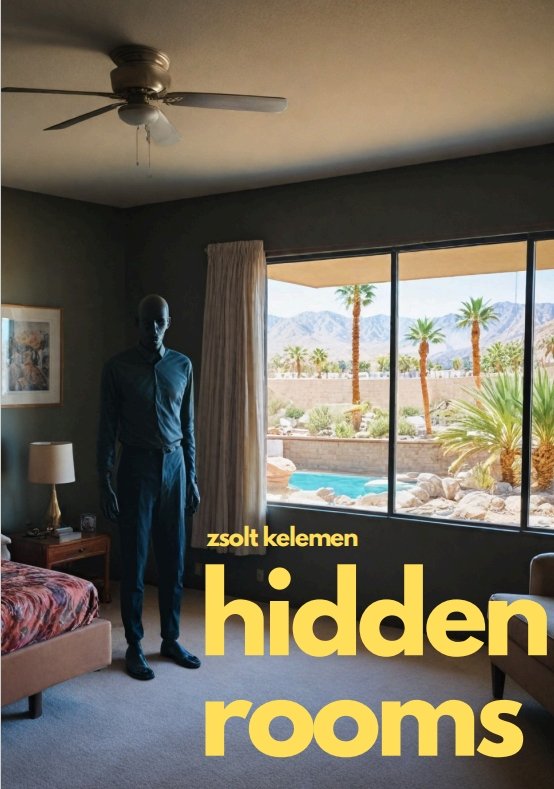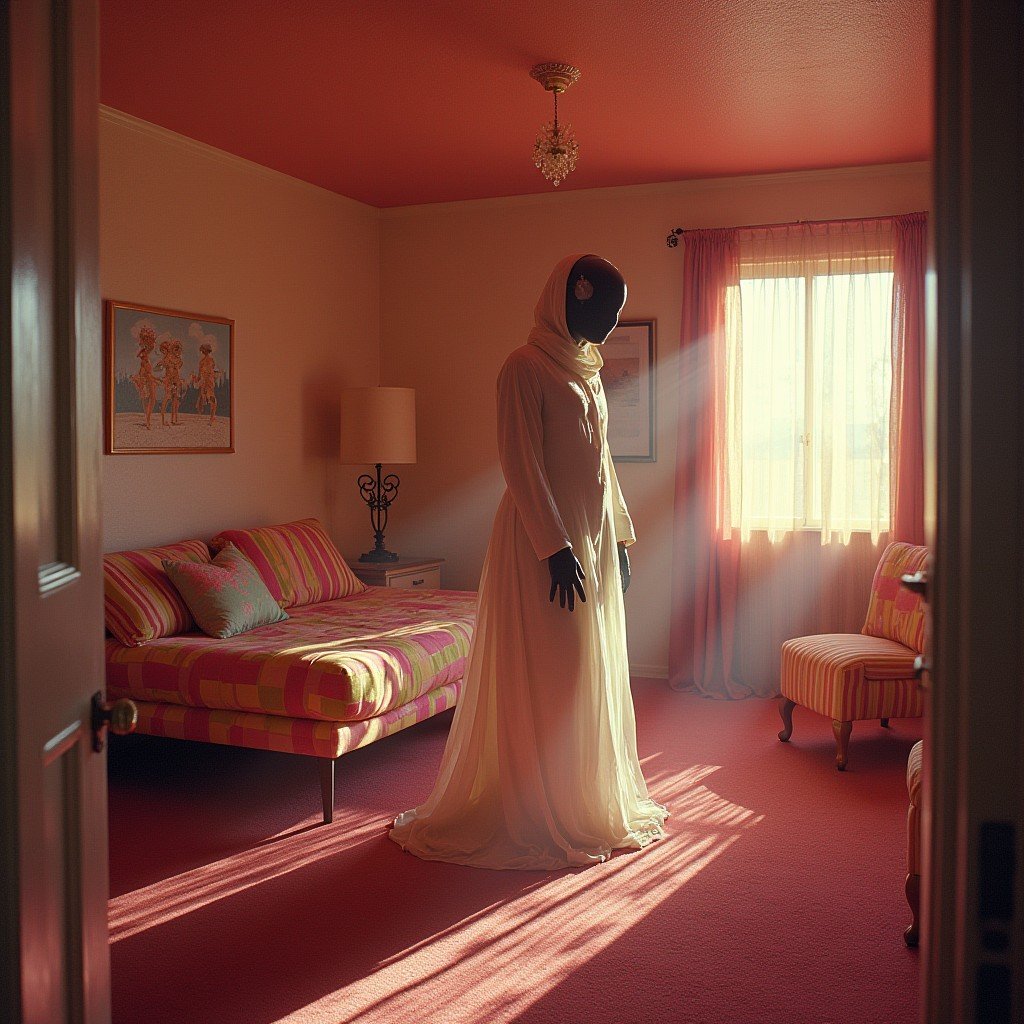 Image 1 of 4
Image 1 of 4

 Image 2 of 4
Image 2 of 4

 Image 3 of 4
Image 3 of 4

 Image 4 of 4
Image 4 of 4





Hidden Rooms
"As a debut visual project, "Hidden Rooms" has the potential to be a pioneering piece in the dialogue between AI and human artistic expression."
"Hidden Rooms" explores the connection between AI and the human condition through seven themes: Curiosity, Shelter, Spirituality, Appetite, Nature, Sex and finally, Death. Through AI-generated pictures through 200 pages, "Hidden Rooms" captures the uncanny, repetitive, yet surreal ways AI interprets these philosophical prompts. "Hidden Rooms" presents itself as an evocative and deeply thought-provoking visual project, exploring the blurred boundaries between human creativity and artificial intelligence. The concept of using AI-generated images to dive into seven core themes of the human condition—Curiosity, Shelter, Spirituality, Appetite, Nature, Sex, and Death—is both ambitious and intriguing. The introductory passage sets the tone for a surreal, almost existential journey. It promises a mix of familiar landscapes rendered unfamiliar through AI’s gaze, offering readers not just a collection of images but an exploration of how technology interprets deeply human, philosophical prompts. The idea of exotopias—speculative spaces that mimic the West Coast yet contain surreal twists—feels fresh and captivating. It's clear the book goes beyond just visual art; it’s about the interplay between human intuition and mechanical logic, inviting readers to reflect on how we perceive reality and imagination. What makes "Hidden Rooms" particularly compelling is the ongoing dialogue between the creator and the AI—a co-authorship where questions of authenticity, creativity, and the "uncanny valley" are front and center. The framing of AI as both a tool and a co-creator adds layers of philosophical depth. The images, complemented by rhythmically strange AI-generated texts, seem to offer a narrative flow that mimics human creativity while reminding us of the inherent nonhuman factor in artificial creations. This project is bound to resonate with readers interested in technology, art, and philosophy. Its exploration of the uncanny and its reflection on human creativity versus machine-generated content provides a rich, multilayered experience. As a debut visual project, "Hidden Rooms" has the potential to be a pioneering piece in the dialogue between AI and human artistic expression.
"As a debut visual project, "Hidden Rooms" has the potential to be a pioneering piece in the dialogue between AI and human artistic expression."
"Hidden Rooms" explores the connection between AI and the human condition through seven themes: Curiosity, Shelter, Spirituality, Appetite, Nature, Sex and finally, Death. Through AI-generated pictures through 200 pages, "Hidden Rooms" captures the uncanny, repetitive, yet surreal ways AI interprets these philosophical prompts. "Hidden Rooms" presents itself as an evocative and deeply thought-provoking visual project, exploring the blurred boundaries between human creativity and artificial intelligence. The concept of using AI-generated images to dive into seven core themes of the human condition—Curiosity, Shelter, Spirituality, Appetite, Nature, Sex, and Death—is both ambitious and intriguing. The introductory passage sets the tone for a surreal, almost existential journey. It promises a mix of familiar landscapes rendered unfamiliar through AI’s gaze, offering readers not just a collection of images but an exploration of how technology interprets deeply human, philosophical prompts. The idea of exotopias—speculative spaces that mimic the West Coast yet contain surreal twists—feels fresh and captivating. It's clear the book goes beyond just visual art; it’s about the interplay between human intuition and mechanical logic, inviting readers to reflect on how we perceive reality and imagination. What makes "Hidden Rooms" particularly compelling is the ongoing dialogue between the creator and the AI—a co-authorship where questions of authenticity, creativity, and the "uncanny valley" are front and center. The framing of AI as both a tool and a co-creator adds layers of philosophical depth. The images, complemented by rhythmically strange AI-generated texts, seem to offer a narrative flow that mimics human creativity while reminding us of the inherent nonhuman factor in artificial creations. This project is bound to resonate with readers interested in technology, art, and philosophy. Its exploration of the uncanny and its reflection on human creativity versus machine-generated content provides a rich, multilayered experience. As a debut visual project, "Hidden Rooms" has the potential to be a pioneering piece in the dialogue between AI and human artistic expression.
"As a debut visual project, "Hidden Rooms" has the potential to be a pioneering piece in the dialogue between AI and human artistic expression."
"Hidden Rooms" explores the connection between AI and the human condition through seven themes: Curiosity, Shelter, Spirituality, Appetite, Nature, Sex and finally, Death. Through AI-generated pictures through 200 pages, "Hidden Rooms" captures the uncanny, repetitive, yet surreal ways AI interprets these philosophical prompts. "Hidden Rooms" presents itself as an evocative and deeply thought-provoking visual project, exploring the blurred boundaries between human creativity and artificial intelligence. The concept of using AI-generated images to dive into seven core themes of the human condition—Curiosity, Shelter, Spirituality, Appetite, Nature, Sex, and Death—is both ambitious and intriguing. The introductory passage sets the tone for a surreal, almost existential journey. It promises a mix of familiar landscapes rendered unfamiliar through AI’s gaze, offering readers not just a collection of images but an exploration of how technology interprets deeply human, philosophical prompts. The idea of exotopias—speculative spaces that mimic the West Coast yet contain surreal twists—feels fresh and captivating. It's clear the book goes beyond just visual art; it’s about the interplay between human intuition and mechanical logic, inviting readers to reflect on how we perceive reality and imagination. What makes "Hidden Rooms" particularly compelling is the ongoing dialogue between the creator and the AI—a co-authorship where questions of authenticity, creativity, and the "uncanny valley" are front and center. The framing of AI as both a tool and a co-creator adds layers of philosophical depth. The images, complemented by rhythmically strange AI-generated texts, seem to offer a narrative flow that mimics human creativity while reminding us of the inherent nonhuman factor in artificial creations. This project is bound to resonate with readers interested in technology, art, and philosophy. Its exploration of the uncanny and its reflection on human creativity versus machine-generated content provides a rich, multilayered experience. As a debut visual project, "Hidden Rooms" has the potential to be a pioneering piece in the dialogue between AI and human artistic expression.




